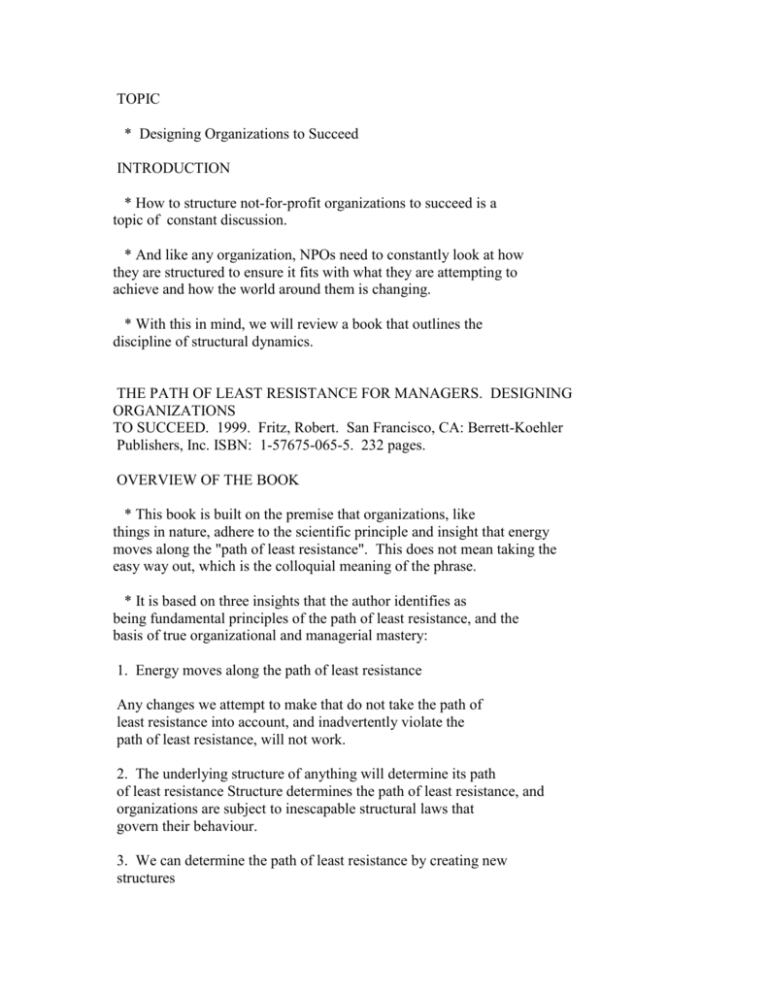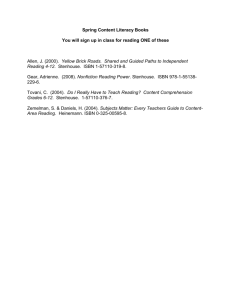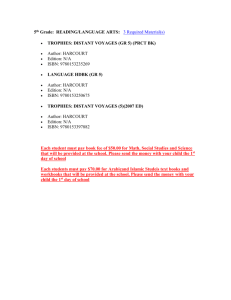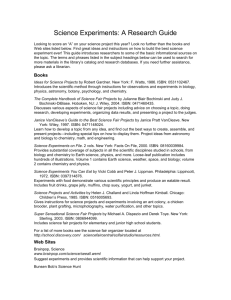Organizational Development Resources
advertisement

TOPIC * Designing Organizations to Succeed INTRODUCTION * How to structure not-for-profit organizations to succeed is a topic of constant discussion. * And like any organization, NPOs need to constantly look at how they are structured to ensure it fits with what they are attempting to achieve and how the world around them is changing. * With this in mind, we will review a book that outlines the discipline of structural dynamics. THE PATH OF LEAST RESISTANCE FOR MANAGERS. DESIGNING ORGANIZATIONS TO SUCCEED. 1999. Fritz, Robert. San Francisco, CA: Berrett-Koehler Publishers, Inc. ISBN: 1-57675-065-5. 232 pages. OVERVIEW OF THE BOOK * This book is built on the premise that organizations, like things in nature, adhere to the scientific principle and insight that energy moves along the "path of least resistance". This does not mean taking the easy way out, which is the colloquial meaning of the phrase. * It is based on three insights that the author identifies as being fundamental principles of the path of least resistance, and the basis of true organizational and managerial mastery: 1. Energy moves along the path of least resistance Any changes we attempt to make that do not take the path of least resistance into account, and inadvertently violate the path of least resistance, will not work. 2. The underlying structure of anything will determine its path of least resistance Structure determines the path of least resistance, and organizations are subject to inescapable structural laws that govern their behaviour. 3. We can determine the path of least resistance by creating new structures We can redesign our organizations so that the path of least resistance begins to flow in the direction we want our organizations to go. This process has two steps: understanding, and then application. * The book also introduces the nine inescapable laws of organizational structure whose insights can be used to understand our current situations and redesign them, as well as the concepts of structural oscillation and structural advancement. * One of the major goals of the book is to help readers create the organization they want. To do this, the book is divided into three parts: Part 1 The Path to Advancement, which focuses on key principles and techniques we can use in organizational design Part 2 The Path of Oscillation, which helps us understand why our best efforts do not always succeed, and why success sometimes leads to new problems and reversals as a product of bad structure Part 3 Elements of Design, which helps to change the path of least resistance from oscillating to advancing structures. PART 1 THE PATH TO ADVANCEMENT * Chapter 1 An Organization's Structure. The Path to Success or Failure This chapter is based on the premise that organizations that take structural laws into account when redesigning themselves are likely to succeed, because a change in the structure of an organization changes the path of least resistance. Structure is defined as an entity made up of individual elements or parts that impact each other by the relationships that they form. It also introduces the first four of the nine laws of organizational structure: Law 1: Organizations either oscillate or advance Law 2: In organizations that oscillate, success is neutralized. In organizations that advance, success succeeds Law 3: If the organization's structure remains unchanged, the organization's behaviour will revert to its previous behaviour Law 4: A change of structure leads to a change of the organization's behaviour. * Chapter 2: Structural Tension. The Secret of Your Success This chapter introduces and explores the concept of structural tension, which is defined as the tension that exists between our desired state as compared to our actual state. The author considers the principle of structural tension to be the most powerful force an organization can have - knowing what we want to create and knowing where we are in relationship to our goals. Three elements of structural tension are also introduced: defining our goals, defining where we are now, and taking action to reach our goals. What is critical is having a good understanding of reality - what it really is, not what people in the organization think it is. Structural tension is considered by the author to be the key ingredient in organizations that advance, and advocates its use as the primary organizing principle. It produces advancement because it promotes organizational behaviours that advance the organization: interrelating of goals, reality is seen objectively, and adjustments to plans and organizational learning become the norm. The fifth law of organizational structure is also introduced: Law 5: When structural tension dominates an organization, the organization will advance. * Chapter 3: Structural Tension Charting. The Key to Organizational Design In structural tension charting, identifying our major goals becomes the driving force for defining our current reality and creating our action plan to reach those goals. What is charted is the major goals at one end, the current reality at the other, and the action plan or structural tension in the middle which sets out how the organization will move from the current reality to the desired reality. To this can be added due dates and accountability to make sure things get done. The chapter stresses that an organization needs to have clear overriding major goals that are clear to everyone, to give the entire organization direction and to coordinate everyone's focus in a common direction. These can then be translated and linked down through the organization at the department, team, and project level. At the macro level, an organization will have a master structural tension chart, and linked, sub-charts cascading down through the organization. * Chapter 4: Telescoping. Creating Organizational Counterpoint Chapter 4 introduces the concept of telescoping, which is a technique for adding progressive levels of detail to a structural tension chart. Each action step on a structural tension chart becomes a goal that is "telescoped" out, or expanded into its own chart. This telescoping process can be taken to several more levels in relation to each action on the new chart, and so on. When an action step from a chart becomes the goal of a new telescoped chart, the same process of describing its current reality, action steps, due dates, and accountability is completed. * Chapter 5: Checklists. Refining the Chart Chapter 5 provides a series of checklists to use as basic principles in structural tension charting. There is a series of questions to use as a checklist for goals, current reality, and action steps. PART 2 THE PATH OF OSCILLATION * Chapter 6: Structural Conflict. Why Organizations Oscillate This chapter looks at the concept of structural conflict, which exists in organizations that have a fundamental structure in which the path of least resistance makes it easiest to support first one course of action, strategy, or tactic, but then later its opposite. Structural conflict is identified as the underlying reason why organizations oscillate. This leads to identification of the sixth law of organizational structure: Law 6: When structural conflicts dominate an organization, oscillation will result. When two tension-resolution systems or goals compete against each other, it produces a structural conflict. A structural conflict between two goals makes both goals difficult to accomplish, and the accomplishment will be reversed. In an attempt to establish equilibrium, the organization and its structure oscillates between the two goals. * Chapter 7: The Problem with Problem Solving This chapter emphasizes that most people look at structural conflicts as problems to be solved. In the author's view they are not, and not only will problem solving not address an organization's oscillation, it can even cause it. Structural conflicts are simply structures that are inadequate to accomplish our ends, which leads to the seventh law of organizational structure: Law 7: An inadequate organizational structure cannot be fixed. But you can move from an inadequate structure to a suitable structure. The focus needs to be placed on understanding why the organization finds itself in its current situation and redesigning its structure, rather than looking at the situation as a problem to be fixed. * Chapter 8: Structural Conflicts of the Rich and Famous The purpose of this chapter is to be able to recognize specific structural conflicts in our own organizations that occur in organizations of all sizes, and to be able to recognize other structural conflicts when we see them. According to this chapter, organizations typically oscillate between: - Expansion and limitation - Strained workload and budgetary constraints - Profit goals and expansion goals - Investment and cost cutting - Stock performance and reinvestment - Short-term and long-term demands - Desire to control and desire to include others in decision making - Desire to act and potential risk - Growth and stability As well, layers of structural conflicts combine to create a wider magnitude of oscillation. By learning to recognize oscillation in our own organizations, we can begin to describe the competing tension-resolution systems that form the structural conflict and better understand the structural forces that are at play and that need to be addressed in order for the organization to advance. * Chapter 9: How to Address Structural Conflicts. The Key to Structural Redesign Reemphasizing that structural conflicts are not problems to be solved but structures that need to be redesigned, this chapter provides the key principle in redesigning structural conflicts - hierarchy. Establishing a hierarchy between competing goals is the key to structural redesign. If there are two or more competing goals, the organization will be in and remain in a state of oscillation and structural conflict. By defining our primary goal we can move to a state of structural tension. The eighth law of organizational structure introduced in this chapter states: Law 8: When a senior organizing principle is absent, the organization will oscillate. When a senior organizing principle is dominant, the organization will advance. PART 3 ELEMENTS OF DESIGN. MOVING FROM THE ROCKING CHAIR TO A FERRARI * Chapter 10: Purpose. What Unifies the Organization This chapter emphasizes that all organizations need to have an identifiable purpose or reason to exist. When an organization's actions contradict its desired purpose, the organization will oscillate. The fundamental structural tension that needs to exist is the difference between the desired expression and the current expression of its purpose. This will change over time, since the organization's purpose is not fixed but continues to grow and develop. * Chapter 11: Business Strategy. The Path of Least Resistance is Our Purpose This chapter emphasizes that we create the path to least resistance that leads to the fulfillment of our purpose through the organization's business strategy - we build a business around the purpose. The business strategy is the process that resolves the structural tension between the organization's purpose, and the current expression of that purpose. It expresses the purpose of the organization and defines how wealth is generated. The management strategy puts the business strategy into practice by defining how work gets done through the coordination of people, systems, and other resources. The chapter offers a number of questions that need to be asked when developing a business strategy: - What is our offering? - Who are our customers? - What do they want? - What do we want? - Is there a match between ours and their wants? - How do they know about us? - How do they obtain our offerings? - What is the current market? - What is the future market? - How will our offerings change? - Where are we going? * Chapter 12: Frames. The Best Way to See Reality This chapter outlines that a structural approach requires dimensional thinking - thinking in multiple units - rather than the usual linear thinking. Of the three frames of reference for thinking - close-up, medium- or long-shot - the medium-shot is advanced as the preferred frame of reference for structural thinking and the best way to see reality. * Chapter 13: Discovering Our True Vision This chapter outlines that vision is the other element in addition to a clear picture of reality that forms structural tension. An organization that lacks vision cannot create structural tension and will oscillate. Vision is seen as aspirations and values of an organization. Without a clear vision, an organization often lets its reactions to prevailing circumstances guide its direction. Advancing organizations have clear aspirations and values and take actions that are true to them. Oscillating organizations don't. * Chapter 14: The Power of Shared Structural Tension This chapter purports that a shared vision is the prime generative force that powers successful organizations. It is a great vision that engenders great values. This leads to the ninth and last law of organizational structure: Law 9: The values that dominate an organization will displace other competing, lesser values. However, what is more powerful than a shared vision is a shared structural tension, which occurs when people not only share the vision but also the current reality of the organization. * Chapter 15: Organizational Greatness. Building on Structural Tension This chapter makes the point that organizational greatness is found in how an organization takes a stand for its aspirations and values. And to achieve organizational greatness, the following elements must be in place: - Power is distributed widely and evenly - Local interests are managed with overall interests in mind - The organization becomes a social force - Principles determine policies - Expansion is clearly defined - Resources are managed within a comprehensive design - People are continually aligned systematically. * Epilogue The epilogue reinforces the main points of the book and urges people within organizations to think and act structurally. * Appendix: Some Afterthoughts and Add-on Points The appendix looks at the recent interest in self-organizing systems and predicts that they will tend to produce oscillating behaviour within an organization as local forces gain strength and power, and begin to clash with each other. With self-organizing systems there is an inability to use and create structural tension as the prime force within an organization. The appendix looks at the concept of an orchestra which is composed of many highly skilled individuals who are brought together and perform well as a unit based on a prime, unifying theme and concept, which is in direct contrast to the concept of self-organizing systems. The appendix also compares structural dynamics and systems thinking and shows how they have many overlapping principles and parallel inclinations, but different in important ways. Within systems thinking the feedback loop is the basic unit. Within structural dynamics it is tension resolution. Structural dynamic practitioners will analyze the various tension-resolution systems within an organization that vie for dominance. They will then work to set up new dynamic relationships of tension-resolution systems to advance the organization and have it move along the path of least resistance. MY THOUGHTS ON THIS PUBLICATION * As Peter Senge points out in his forward to this book, Robert Fritz has a completely different way of looking at organizations and how they need to be structured and operate. * Structural tension has the potential to be the unifying concept that helps pull NPOs together and point them in the right direction - the direction that they collectively choose. * Taking a hard, realistic look at their structure and its impact on its ability to achieve what it has set out to achieve is difficult for many NPOs. * This in very unfortunate, since the best strategic plan in the world is not worth much unless the NPO asks itself whether it has the structure in place that it needs to implement and fulfill the plan. * In my view and experience, this is one of the main reasons why many strategic plans collect dust on a shelf. They have little to no impact on the day-to-day operations of the NPO because the next step of determining how the structure needs to change is not addressed. * As Peter Senge alludes to in his forward, if you want to fly you have to have a vehicle that is structured to fly. There are basic principles that have to be respected, but as we all know, there are lots of different plane designs that do the job. You need to build one that flies the way it needs to, to reach your objective. MY RECOMMENDATION * Every not-for-profit organization can benefit from the concepts and approach in this book. * If you take the reviews I have done on strategic planning and the balanced scorecard, this book fits neatly in between the two. The strategic planning references help you decide what your organization is going to do, structural dynamics gives you a way of setting up or modifying your structure to be able to achieve it, and the balanced scorecard gives you a way of measuring how well you are doing. * For many not-for-profit organizations this topic is very important, since many are being faced with resource cuts that are forcing them to reexamine how they are and need to be structured under this new reality, and there are many who have had the same structure for many years and the question should be asked whether structural changes to the organization need to be made. * Applying the principles and concepts of structural dynamics may be a bit unnerving, but the consequences of not doing so may be far more difficult to face. WHERE THE PUBLICATION IS AVAILABLE * This publication is available from many sources, including: Chapters: Website: http://www.chapters.indigo.ca Cost: CDN $29.95 Robert Fritz: Website: http://www.robertfritz.com/home.htm Cost: US $18.95 ROBERT FRITZ WEBSITE * Visit Robert Fritz's website. There is lots of material here to give you a better feel for what he's all about. MY NEXT E-MAIL REVIEW NUMBER 17 Winter 2003 * Topic: Revenue Diversification for NPOs. * In past reviews I have looked at concepts such as venture philanthropy. * In my next review I will take a look at a book published this year by the Canadian Society of Association Executives on revenue diversification for NPOs: A Guide to Revenue Diversification for Directors of Non-Profit Organizations. Venture Philanthropy, Commercial Ventures and Venture Capital Opportunities for Associations, Charities, and other Non-Profit Organizations. 2003. Pepin, John. Toronto, ON: Canadian Society of Association Executives. ISBN: 0-921998-34-1. 72 pages. * When NPOs do a strategic plan this is almost an inevitable conclusion and recommendation - that the organization needs to increase its revenue and diversify its revenue sources. * This makes sense, since most NPOs could do with more money. What makes even more sense is to diversity those revenue sources so that the organization does not rely on too few sources, which if lost or reduced, has the potential to cause anywhere from minor financial instability to catastrophic financial consequences for the organization. PAST E-MAIL REVIEWS Number 1, October 2000 THE POLICY GOVERNANCE FIELDBOOK. PRACTICAL LESSONS, TIPS, AND TOOLS FROM THE EXPERIENCES OF REAL-WORLD BOARDS. 1999. Oliver, Caroline, General Editor, et al. San Francisco, CA: Jossey-Bass Publishers. ISBN 0-7879-4366-5. 242 pages. Cdn $44.95. US $29.95. Number 2, January 2001 POOR RICHARD'S WEB SITE. Geek-Free, Commonsense Advice on Building a Low-Cost Web Site. Second Edition. 2000. Kent, Peter. Lakewood, CO: Top Floor Publishing. 422 pages. US $29.95. ISBN: 0-9661032-0-03. POOR RICHARD'S E-MAIL PUBLISHING. Creating Newsletters, Bulletins, Discussion Groups, and Other Powerful Communication Tools. 1999. Pirillo, Chris. Lakewood, CO: Top Floor Publishing. 344 pages. US $29.95. ISBN: 0-9661032-5-4. POOR RICHARD'S INTERNET MARKETING AND PROMOTIONS. How to Promote Yourself, Your Business, Your Ideas Online. 1999. Kent, Peter, and Calishain, Tara. Lakewood, CO: Top Floor Publishing. 404 pages. US $29.95. ISBN: 0-9661032-7-0. Number 3, March 2001 THE FIFTH DISCIPLINE. The Art & Practice of The Learning Organization. 1990. Senge, Peter. New York, NY: Doubleday. 423 pages. Approximately CDN $38.00. Prices seem to vary. ISBN: 0-385-26095-4. THE FIFTH DISCIPLINE FIELDBOOK. Strategies and Tools for Building a Learning Organization. 1994. Senge, Peter, et al. New York, NY: Doubleday. 593 pages. Between CDN $38.00 - $45.95. ISBN: 0-385-47256-0. THE DANCE OF CHANGE. The Challenges of Sustaining Momentum in Learning Organizations. A Fifth Discipline Resource. 1999. Senge, Peter, et al. New York, NY: Doubleday. 596 pages. CDN $55.00. ISBN: 0-385-493223. Number 4, May 2001 THE ART OF FOCUSED CONVERSATION. 100 Ways to Access Group Wisdom in the Workplace. 1997. Stanfield, R. Brian. General Editor. Toronto, ON: The Canadian Institute of Cultural Affairs (ICA Canada). 222 pages. CDN $31.95. ISBN: 0-921690-57-6. Number 5, July 2001 STRATEGIC SAFARI: A GUIDED TOUR THROUGH THE WILDS OF StRATEGIC MANAGEMENT. 1998. Mintzberg, Henry, Ahlstrand, Bruce, and Lampel, Joseph. New York, NY: Free Press. 406 pages. CDN $38.00. ISBN: 0-684847-43-4. Number 6, September 2001 DUTIES AND RESPONSIBILITIES OF DIRECTORS OF NON-PROFIT CORPORATIONS. 1999. Kelly, Hugh M., Q.C. and Frederick, Mark R. Toronto, ON: Canadian Society of Association Executives (CSAE). 36 pages. ISBN: 0-921998-16-3. VOLUNTEERS & THE LAW. A GUIDE FOR VOLUNTEERS, ORGANIZATIONS AND BOARDS. 2000 Edition. Third Edition. Vancouver, BC: The Law Foundation of British Columbia, The People's Law School, and Volunteer Vancouver. 71 pages. ISBN: 0-88847-131-9. Number 7, November 2001 THE ENTREPRENEURIAL NONPROFIT EXECUTIVE. THE MYTHS. THE MONEY. THE PEOPLE. A GUIDE TO PRUDENT RISK-TAKING IN THE SERVICE OF A LARGER MISSION. 1991. McLaughlin, Thomas A. Rockville, Maryland: Fund Raising Institute, A Division of the Taft Group. ISBN: 0-930807-22-7. 264 pages. Number 8, January 2002 EFFECTIVE CAPACITY BUILDING IN NONPROFIT ORGANIZATIONS. August 2001. Prepared by McKinsey and Company. Published by Venture Philanthropy Partners, an entrepreneurial venture of the Morino Institute. 120 pages. www.venturephilanthropypartners.org. Number 9, March 2002 THE BASICS OF PERFORMANCE MEASUREMENT. 1997. Harbour, Jerry L., Ph.D. New York, NY: Quality Resources. ISBN: 0-527-76328-4. 70 pages. CDN $12.50. THE BALANCED SCORECARD: TRANSLATING STRATEGY INTO ACTION. 1996. Kaplan, Robert S. and Norton, David P. Boston, MA: Harvard Business School Press. ISBN: 0-87584-651-3. 322 pages. CDN $47.50. THE STRATEGY-FOCUSED ORGANIZATION. HOW BALANCED SCORECARD COMPANIES THRIVE IN THE NEW BUSINESS ENVIRONMENT. 2001. Kaplan, Robert S., and Norton, David P. Boston, MA: Harvard Business School Press. ISBN: 1-57851-250-6. 400 pages. CDN $47.95. Number 10, May 2002 VENTURE PHILANTHROPY 2001: THE CHANGING LANDSCAPE. The Morino Institute. Prepared by Community Wealth Ventures, Inc. www.venturephilanthropypartners.org. Number 11, July 2002 HIGH PERFORMANCE NONPROFIT ORGANIZATIONS. MANAGING UPSTREAM FOR GREATER IMPACT. 1999. Letts, Christine; Ryan, William, P.; Grossman, Allen. New York, NY: John Wiley & Sons, Inc. ISBN: 0-471-17457-2. 207 pages. Number 12, September 2002 BALANCED SCORECARD STEP-BY-STEP: MAXIMIZING PERFORMANCE AND MAINTAINING RESULTS. 2002. Niven, Paul R. Toronto, ON: John Wiley & Sons. ISBN: 0-471-07872-7. CDN $67.50. Number 13, November 2002 "AFTER GOVENMENT CUTS: INSIGHTS FROM TWO ONTARIO 'ENTERPRISING NONPROFITS'." in THE NONPROFIT SECTOR IN CANADA: ROLES AND RELATIONSHIPS, pp. 107-148. 2001. Banting, Keith, editor. Kingston, ON: Queen's University School of Policy Studies. ISBN: 0-88911-813-2. 266 pages. Number 14, January 2003 PRIMER FOR DIRECTORS OF NOT-FOR-PROFIT CORPORATIONS. Rights, Duties and Practices. 2002. Broder, Peter, co-ordinating editor. Ottawa, ON: Industry Canada. ISBN: 0-662-32550-8. 99 pages. Number 15, May 2003 THE WORKSHOP BOOK. FROM INDIVIDUAL CREATIVITY TO GROUP ACTION.2002. Stanfield, Brian R. Toronto, ON: The Canadian Institute for Cultural Affairs (ICA Canada), and Gabriola Island, BC: New Society Publishers (co-publishers). ISBN: 0-86571-470-3, 171 pages. If you would like a copy of a previous review, please send an e-mail request to dgolob@telus.net. Donald Golob Donald Golob Consulting Facilitation, Strategic Planning, and Organizational Development Specializing in Services for Not-For-Profit Organizations 2522 Kilmarnock Crescent North Vancouver, BC V7J 2Z5 Tel: 604 988 3273 Fax 604 988 3285 Email: dgolob@telus.net Member International Association of Facilitators Member International Association for Public Participation One of the Leading Not-For-Profit Sector Consultants in Western Canada







